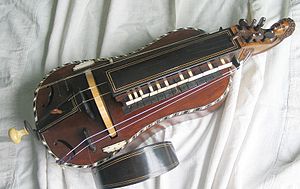Jacques-Christophe Naudot
Jacques-Christophe Naudot (* around 1690; † November 26, 1762 in Paris ) was a French composer and flautist.
Life
Jacques-Christophe Naudot lived as “ maître de flutte et de muzique ” in Paris from 1719 at the latest , where he was supported by the young Count Egmont and Duke von Geldern, to whom he dedicated several works. Even various royal printing privileges (from 1726) brought him no public office, he earned his living by selling his works and as a flute teacher. In his marriage certificate he is only listed as “Maitre de musique”; he lived in a baker's house near the Pont Neuf. As a soloist, he often appeared at the Concert spirituel .
He composed mostly works for his instrument, such as concerts, sonatas, duos with and without figured bass, which were mainly published in Paris between 1726 and 1740.
As a member of the upper classes, he maintained contacts with aristocrats and rich citizens, whose protection also benefited him musically. In 1737 he was a founding member of the Masonic Lodge "Coustos-Villeroy". Presumably in the same year he introduced the composer Louis-Nicolas Clérambault and his son to the same lodge.
He was acquainted with Joseph Bodin de Boismortier , since he published two collections of works with him in 1752.
Often found in his works are the vièle ( hurdy-gurdy ) and the musette (a baroque bagpipe ), instruments that were popular in France around the mid-18th century. They underlined a reflection on rural life, which at the time enjoyed great popularity among aristocratic circles.
Works
With opus number
- opus 1: 6 sonates pour la flûte traversière avec la basse (1726) - dedicated to the Comte d'Egmont
- opus 2: 6 sonates en trio pour deux flûtes traversières et la basse (1726)
- opus 3: 6 sonates pour deux flûtes traversières sans basse (1727)
- opus 4: 6 sonates pour la flûte traversière avec la basse (1728)
- opus 5: 6 sonates pour deux flûtes traversières sans basse (1728)
- opus 6: 6 sonates pour deux flûtes traversières sans basse (1728)
- opus 7: 6 sonates et un Caprice en trio pour deux flûtes traversières, violons, et hautbois avec la basse; dont il y en a trois peuvent se jouer sur les musettes, vièles et flûtes à bec (v.1730) - dedicated to the wife of Jean-Paris de Monmartel.
- opus 8: 6 Fêtes rustiques en trio pour les musettes, vièles, flûtes, hautbois or violons avec la basse (av. 1737)
- opus 9: 6 sonates pour la flûte traversière avec la basse, la 5e peut se jouer sur la musette (v.1737)
- opus 10: 6 Babioles pour deux vèles, musettes ou other instruments sans basse (1737)
- opus 11: 6 concertos en sept parties pour la flûte, trois violons, un alto-viole et deux basses (1737) - Dedicated to the Comte d'Egmont
- opus 12: Various pieces pour la flûte traversière avec la basse (1737)
- opus 13: 6 sonates pour la flûte traversière avec la basse (v.1740)
- opus 14: 6 sonates dont trois sont par accords pour la vièle avec la basse (v.1740)
- opus 15: 6 sonates en trio pour deux flûtes traversières et basse (1740)
- opus 16: 6 sonates pour une flûte traversière et basse (1740)
- opus 17: 6 concertos pour les vièles ou musettes, deux violons et basse continue (1742) - Dedicated to Danguy l'aîné (virtuoso on this instrument): “ A Monsieur Danguy Laisné. Monsieur, Je croirois manquer de reconnaissance, si je ne vous offrois un ouvrage qui vous doit le jour, et sur lequel vous avés tant de droit: vôtre belle Execution, vos sons touchans, le goût que vous lui donnés en le joüant qui a ravi tous ceux qui vous ont entend, sont autant de raisons pour vous l'offrir (...) ”.
Without opus
- Les Plaisirs de Champigny for musette, hurdy-gurdy, flutes and bass
- Petit livre de pièces pour deux cors de chasse, for trumpet, flute or oboe (1733)
- Divertissement champêtre en trio pour musette or hurdy-gurdy, flute and violin (1749)
- 25 menuets pour deux cors de chasse, trumpets, flutes, oboes, violins and treble viol (1748)
- L'Etrenne d'Iris , cantate à voix seule avec accompagnement de flûte ou de violon (1736)
- Chansons notées de la très vénérable confrérie des Maçons libres (1737)
- Noëls choisis et connus avec leurs variations pour deux flûtes traversières or other instruments, ajustés by M. Naudot. Paris, Boismortier, Mme Boivin, Le Clerc (1752)
- Airs choisis et connus en duo avec leurs variations pour deux flûtes traversières ou other instruments. Paris, Boismortier, Mme Boivin, Le Clerc (1752).
literature
- TJ Underwood, The Life and Music of Jacques-Christophe Naudot (unpublished thesis, North Texas State University, 1970).
- JM Bowers, The French Flute School from 1700 to 1760 (unpublished thesis, University of California, Berkeley, 1971).
- R. Cotte, La musique Maçonnique et ses musiciens , ed. Du Baucens, Braine-le-Comte, 1975, ISBN 2904724087
- In: Alfred Baumgartner: Propylaea world of music - The composers - A lexicon in five volumes . Propylaen Verlag, Berlin 1989, ISBN 3-549-07830-7 , pp. 148, volume 4 .
Web links
- Sheet music and audio files by Jacques-Christophe Naudot in the International Music Score Library Project
Individual evidence
- ↑ Archived copy ( Memento of the original dated May 3, 2008 in the Internet Archive ) Info: The archive link was inserted automatically and has not yet been checked. Please check the original and archive link according to the instructions and then remove this notice.
- ^ Marianne Bröcker: The hurdy-gurdy. 2nd Edition. Publishing house for systematic musicology, Bonn - Bad Godesberg 1977, p. 217
| personal data | |
|---|---|
| SURNAME | Naudot, Jacques-Christophe |
| BRIEF DESCRIPTION | French flautist and composer |
| DATE OF BIRTH | around 1690 |
| DATE OF DEATH | November 26, 1762 |
| Place of death | Paris |

